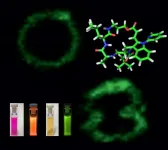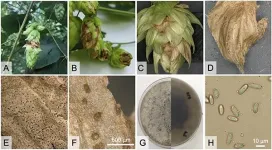(Press-News.org) Brazilian researchers have simultaneously demonstrated the mechanism linking high blood pressure to elevated intracranial pressure, validated a non-invasive intracranial pressure monitoring method, and proposed a treatment for high blood pressure that does not affect intracranial hypertension.
The study was supported by FAPESP and involved collaboration between researchers at São Paulo State University (UNESP) and Brain4care, a startup based in São Carlos. It could result in novel treatments for intracranial hypertension and its complications, including stroke. The main findings are reported in the journal Hypertension.
The researchers monitored blood pressure and intracranial pressure in rats for six weeks. “We set out to investigate what happened to intracranial pressure during the period in which the animals were becoming hypertensive. We were the first to succeed in monitoring this process non-invasively, tracking changes in the shape of the intracranial pressure curve. Our study suggests that intracranial hypertension can be prevented if diagnosed early and treated with losartan, a drug widely used by patients with high blood pressure. It blocks the action of angiotensin II [a naturally occurring peptide that can cause vasoconstriction and an increase in blood pressure], which we also show to be important to control intracranial pressure,” said Eduardo Colombari, principal investigator for the study. Colombari is a professor at UNESP’s Dental School in Araraquara (FOAr).
Intracranial pressure typically increases because of a tumor, encephalitis, meningitis, aneurysm or similar problems, but the researchers showed that chronic high blood pressure can also impair cerebral compliance, leading to a rise in intracranial pressure.
In the study the researchers used vascular clips to simulate renal artery obstruction in rats, restricting the flow of blood to one kidney. The reduced irrigation triggered the pressure-controlling renin-angiotensin system, leading the kidney to release peptides, enzymes and receptors that constrict the blood vessels and raise blood pressure throughout the organism. In the third week of monitoring, when the rats were considered hypertensive, blood pressure rose even more, causing fluid retention and above all boosting cerebral blood flow.
“If the hypertension isn’t treated, the disorder can worsen,” Colombari said. “The rise in intracranial pressure caused by systemic hypertension impairs the brain’s ability to stabilize the pressure [cerebral autoregulation]. This can also lead to blood-brain barrier rupture. Our study showed that the rats’ blood-brain barrier was compromised in the third week. When the barrier is breached, substances and products from the renin-angiotensin system as well as pro-inflammatory substances present in the blood vessels can enter the interstitial space, where the neurons reside, especially regions important to integrative neurohumoral adjustment, such as the cardiovascular, respiratory, and renal systems, among others.”
Treating intracranial hypertension
Blood-brain barrier disruption endangers areas of the nervous system that are important to control cardiovascular pressure as a whole. “How is intracranial hypertension treated now? By inducing a coma or administering a diuretic to resolve fluid retention in the skull. These methods are relatively unspecific and highly systemic. Deeper understanding of the link between high blood pressure and intracranial hypertension points to the possibility of a new field of study in pharmacology,” said Gustavo Frigieri, Brain4care’s Scientific Director.
Part of the study involved a comparison between intracranial pressure measured by the non-invasive sensor and by the invasive method. The wearable sensor developed by Brain4care has been used to measure intracranial pressure in patients with systemic impairments and has been licensed by the National Health Surveillance Agency (ANVISA) in Brazil and the Food and Drug Administration (FDA) in the United States.
Frigieri also sees plenty of opportunities for applications in basic research. “By comparing the non-invasive and invasive methods, we validated our technology for use in scientific research with small animals,” he said. “It can close gaps left open owing to the aggressiveness of the conventional method, which entails a significant risk of infection because a hole is drilled in the skull to insert a sensor.”
Blood flow and hormones
At the end of the study, the researchers treated the animals with losartan, reducing blood pressure and intracranial pressure. “It’s not a cause-and-effect relationship because intracranial pressure wasn’t affected when we lowered blood pressure with a vasodilator [hydralazine]. We observed a major impairment of the brain, and the angiotensin inhibitor [losartan] improved both blood pressure and cerebral blood flow,” Colombari said.
In the sixth week of the experiment, before administration of any drugs, blood pressure was high (190 per 100 mmHg) and intracranial pressure had risen significantly. The researchers discovered alterations in the intracranial pressure pulse waveforms. Each heartbeat (systolic or diastolic) pumps blood to the brain, originating the first peak (P1). A second wave (P2) correlates directly with intracranial arterial volume and cerebral compliance, important factors observed immediately before ventricular diastole.
According to the researchers, the second wave is associated with brain tissue compliance and arterial elasticity in the skull so that the energy of the first wave is absorbed. However, blood-brain barrier disruption and loss of cerebral compliance hinders control of P2, and the first wave becomes stronger than the second.
“At this point we found P2 to be higher than P1, which is the opposite of the normal situation. This is due to loss of protection by the blood-brain barrier so that the brain expands and fluid leaks into the interstitium,” Colombari said.
INFORMATION:
About São Paulo Research Foundation (FAPESP)
The São Paulo Research Foundation (FAPESP) is a public institution with the mission of supporting scientific research in all fields of knowledge by awarding scholarships, fellowships and grants to investigators linked with higher education and research institutions in the State of São Paulo, Brazil. FAPESP is aware that the very best research can only be done by working with the best researchers internationally. Therefore, it has established partnerships with funding agencies, higher education, private companies, and research organizations in other countries known for the quality of their research and has been encouraging scientists funded by its grants to further develop their international collaboration. You can learn more about FAPESP at http://www.fapesp.br/en and visit FAPESP news agency at http://www.agencia.fapesp.br/en to keep updated with the latest scientific breakthroughs FAPESP helps achieve through its many programs, awards and research centers. You may also subscribe to FAPESP news agency at http://agencia.fapesp.br/subscribe.
Biomolecules regulate the biological functions inside every living cell. If scientists can understand the molecular mechanisms of such functions, then it is possible to detect the severe dysfunction which can lead to illness. At a molecular level, this can be achieved with fluorescent markers that are specifically incorporated into the respective biomolecules. In the past, this has been achieved by incorporating a marker in the bio-molecule by completely rebuilding it from the beginning, necessitating a large number of steps. Unfortunate-ly, this approach not only takes a lot of time and resources, but also produces unwanted waste products. Researchers at the Universities of Göttingen and Edinburgh have now ...
If you're a beer drinker, you've noticed that hoppy beers have become increasingly popular. Most of the nation's hops come from the Pacific Northwest. However, commercial hop production regions have expanded significantly. In Michigan hop production nearly tripled between 2014 and 2017 and in 2019, Michigan growers harvested around 720 acres of hops.
Michigan hop growers contend with unique challenges as a result of frequent rainfall and high humidity during the growing season. In 2018, growers approached Michigan State University researchers and the Michigan State University's Plant & Pest Diagnostics lab with concerns about a leaf blight ...
ORLANDO, June 2021 - A new study co-authored by University of Central Florida researchers shows that pre-Columbian people of a culturally diverse but not well-documented area of the Amazon in South America significantly altered their landscape thousands of years earlier than previously thought.
The findings, published in the journal Proceedings of the National Academy of Sciences, show evidence of people using fire and improving their landscape for farming and fishing more than 3,500 years ago. This counters the often-held notion of a pristine Amazon during pre-Columbian times before the arrival of Europeans in the late 1400s.
The study, ...
Climate change and social inequality are two pressing issues that often overlap. A new study led by Princeton researchers offers a roadmap for cities to address inequalities in energy use by providing fine-grained methods for measuring both income and racial disparities in energy use intensity. Energy use intensity, the amount of energy used per unit floor area, is often used as a proxy for assessing the efficiency of buildings and the upgrades they receive over time. The work could guide the equitable distribution of rebates and other measures that decrease energy costs and increase efficiency.
Examining inequality in cities has been hampered ...
"The big mystery about plankton is what controls its distribution and abundance, and what conditions lead to big plankton blooms," said Dennis McGillicuddy, Senior Scientist and Department Chair in Applied Ocean Physics and Engineering at the Woods Hole Oceanographic Institution (WHOI).
Two new papers explore this question and provide examples of conditions that lead to massive plankton blooms with vastly different potential impacts on the ecosystem, according to McGillicuddy, co-author of both papers. Both papers also point to the importance of using advanced technology--including Video Plankton Recorders, autonomous underwater vehicles, and the Ocean Observatories Initiative's Coastal Pioneer Array--to find and monitor these blooms.
In one paper, Diatom Hotspots Driven ...
Key Takeaways:
Study finds non-tiered customer loyalty programs create a more sustainable customer base.
Non-tiered customer loyalty programs are not as likely to generate increases in spending per transaction or accelerate transactions.
CATONSVILLE, MD, June 7, 2021 - Customer loyalty programs have been around for decades and are used to help businesses, marketers and sellers build a sustainable relationship with their customers. But do they work? A recent study sought to find out and researchers learned that while yes, customer loyalty programs do work, perhaps not in ways most may assume.
There are two basic ...
LA JOLLA--(June 7, 2021) Type 1 diabetes, which arises when the pancreas doesn't create enough insulin to control levels of glucose in the blood, is a disease that currently has no cure and is difficult for most patients to manage. Scientists at the Salk Institute are developing a promising approach for treating it: using stem cells to create insulin-producing cells (called beta cells) that could replace nonfunctional pancreatic cells.
In a study published on June 7, 2021, in the journal Nature Communications, the investigators reported that they have developed a new way to create beta cells that is much more efficient than previous methods. Additionally, when these beta cells were tested in a mouse model of type 1 diabetes, ...
WHAT:
New findings published in JAMA Neurology suggest there is no difference in cognitive outcomes at age 2 among children of healthy women and children of women with epilepsy who took antiseizure medication during pregnancy. The findings are part of the large research project Maternal Outcomes and Neurodevelopmental Effects of Antiepileptic Drugs (MONEAD), which is a prospective, long-term study looking at outcomes in pregnant women with epilepsy and their children. The study was funded by the National Institute of Neurological Disorders and Stroke (NINDS), part of the National Institutes of Health. ...
Youth brain activation data from the largest longitudinal neuroimaging study to date provides valuable new information on the cognitive processes and brain systems that underlie adolescent development and might contribute to mental and physical health challenges in adulthood. The study published today online in END ...
Artificial intelligence natural language computer applications are becoming increasingly sophisticated, raising the possibility that they could assume a greater role in health care, including interacting with patients. But before these applications enter the clinic, their potential and pitfalls need thoughtful exploration, states a new article in NPJ Digital Medicine.
The authors are Diane M. Korngiebel, a Hastings Center research scholar, and Sean D. Mooney, chief research information officer at University of Washington Medicine.
"There is compelling promise and serious hype in AI applications that generate natural language" Korngiebel and Mooney write, referring to OpenAI's Generative Pre-trained Transformer 3 (GPT-3) ...






